Python教程-在Python中使用Gmail API

在这个教程中,我们将学习有关Python中的Gmail API,并且我们还将学习如何在Python中使用Gmail API执行许多Gmail操作,如发送电子邮件、搜索电子邮件、删除电子邮件等。为此,我们将学习如何在我们的Python脚本中设置Gmail API。首先,让我们简要了解一下Gmail API及其基本介绍。
Gmail API
Gmail是当今世界上最流行的邮件服务,几乎所有人和许多组织都在使用它。在过去的几年中,许多Gmail功能都得到了增强,包括在撰写电子邮件时的建议以及安全功能(检测欺诈和垃圾邮件)。
Gmail API是基于RESTfulAPI的API,允许用户与我们的Gmail帐户交互,并帮助我们使用Python脚本使用其功能。
在Python中使用Gmail API的先决条件
我们必须满足以下要求才能在我们的Python脚本中使用Gmail API:
- 我们的Python版本应该大于或等于2.6。
- 我们必须拥有启用了Gmail服务的Google帐户。
- 系统必须安装BeautifulSoup库(如果没有安装,则应在命令终端中使用'pip install bsp'语法将其安装在我们的设备上)。
- 我们应该对Google OAuth库和Google API客户端有基本了解。
安装所需的库:
在启用Gmail API以在我们的Python脚本中使用它们之前,让我们首先在系统中安装所需的预先要求库。为了安装启用Gmail API所需的预先要求库,我们应该按照以下步骤进行:
步骤1: 打开系统的命令提示符终端,并确保我们的设备有活动的互联网连接。
步骤2: 在终端中输入以下命令:
- pip install --upgrade google-api-python-client google-auth-httplib2 google-auth-oauthlib
现在,按Enter键开始安装库。
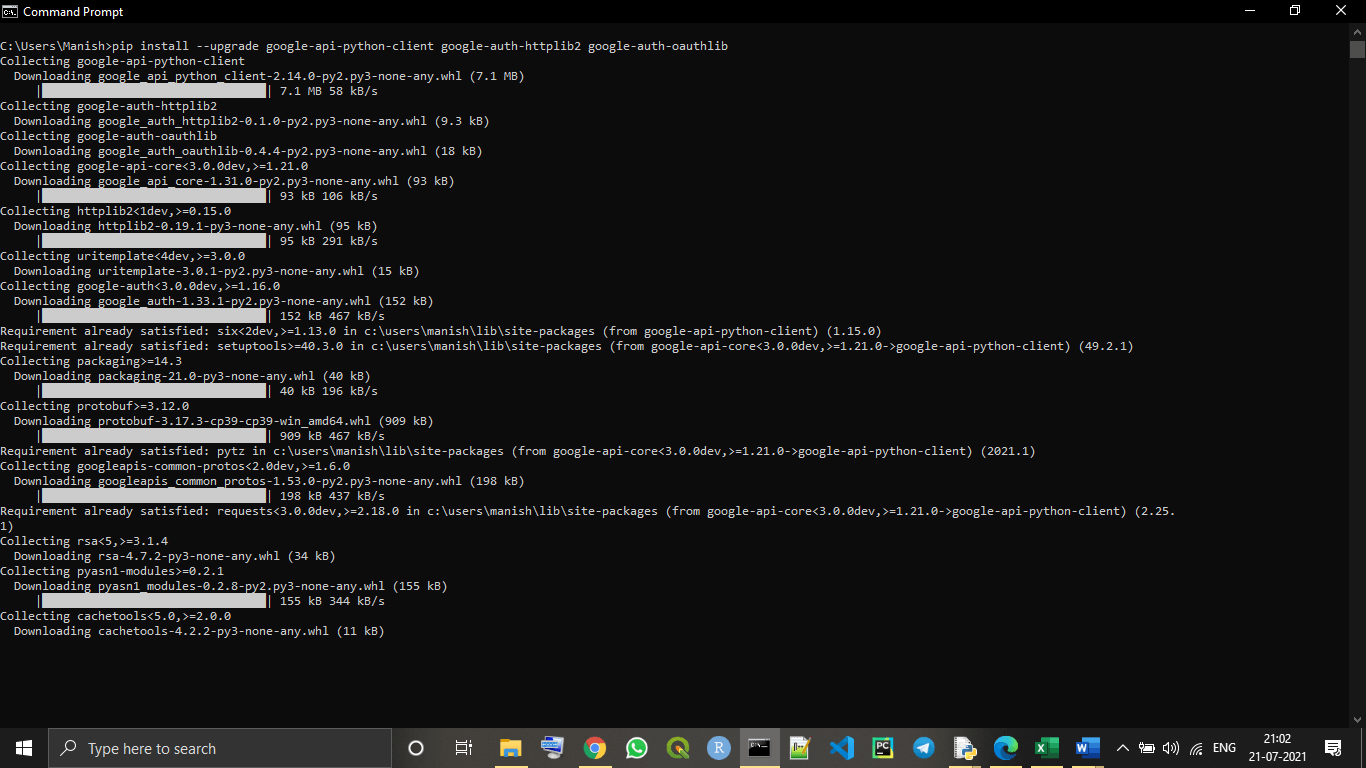
正如我们所见,已成功安装了启用Gmail API所需的预先要求库。现在,我们可以继续进行本教程中的启用Gmail API部分。
在我们的设备中启用Gmail API
我们必须按照以下给定的步骤在我们的设备中启用Gmail API,以便我们可以在Python脚本中使用这些API:
步骤1:在Google Cloud控制台上创建新项目:
在这一步中,首先,我们必须使用我们的Google帐户登录到Google Cloud控制台https://console.cloud.google.com/,然后我们必须点击“新建项目”以创建一个新项目。
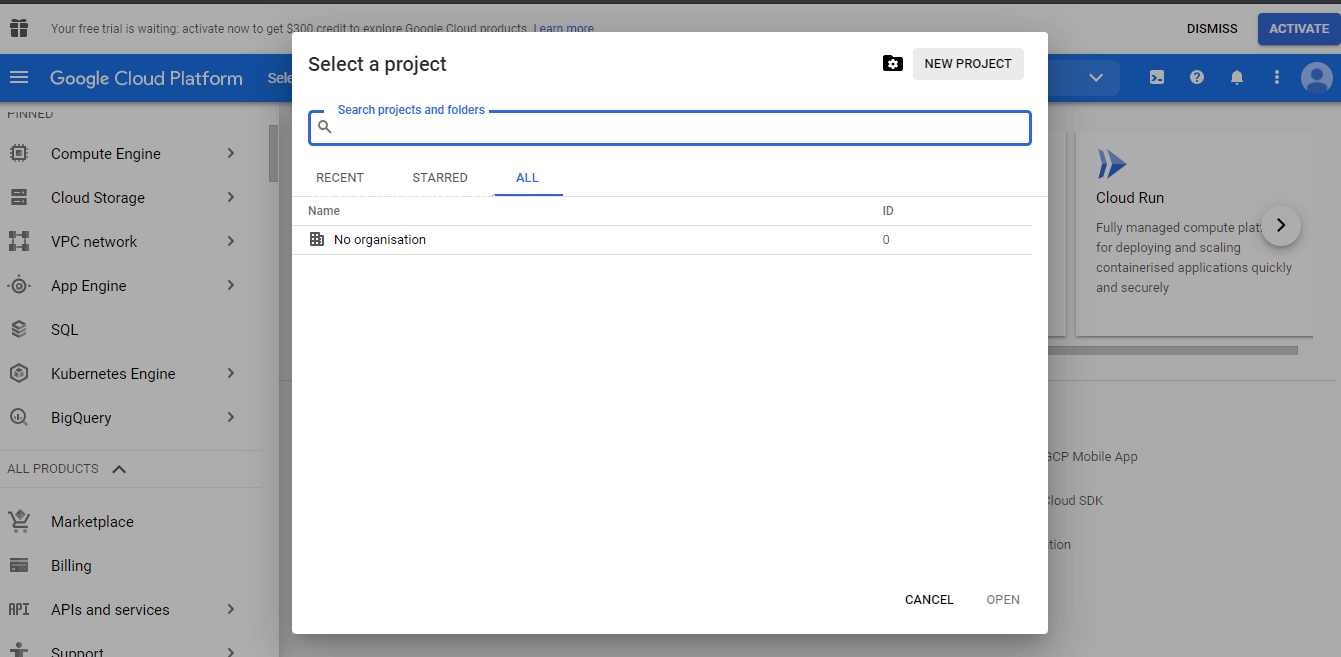
如果我们已经有现有的项目,那么我们也可以继续使用现有的项目。
步骤2: 现在,我们必须从我们创建的项目的项目菜单中选择API和服务选项。
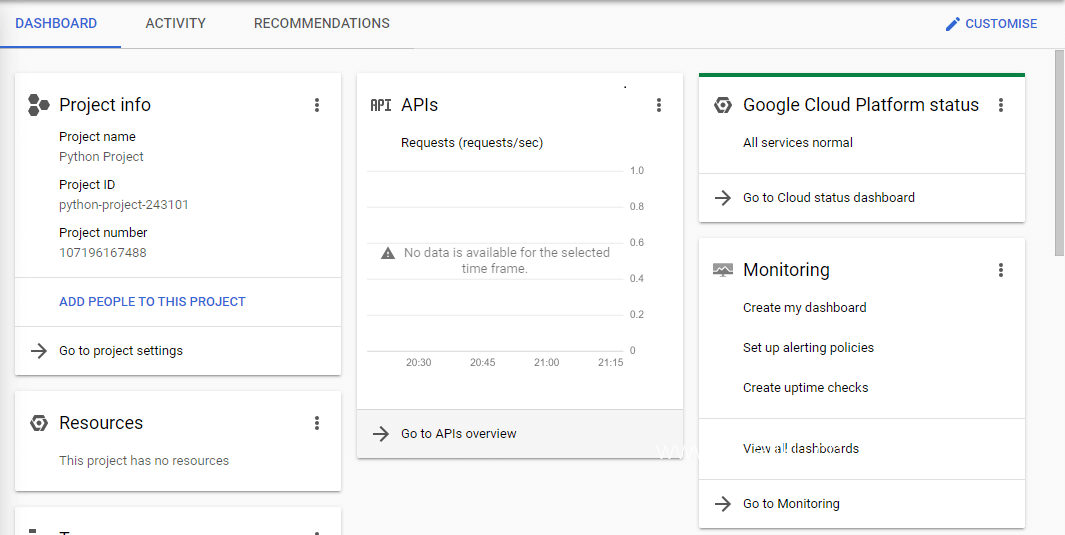
步骤3: 现在,我们可以看到“启用Gmail API和服务”的选项,我们必须选择此选项以为项目启用Gmail API。
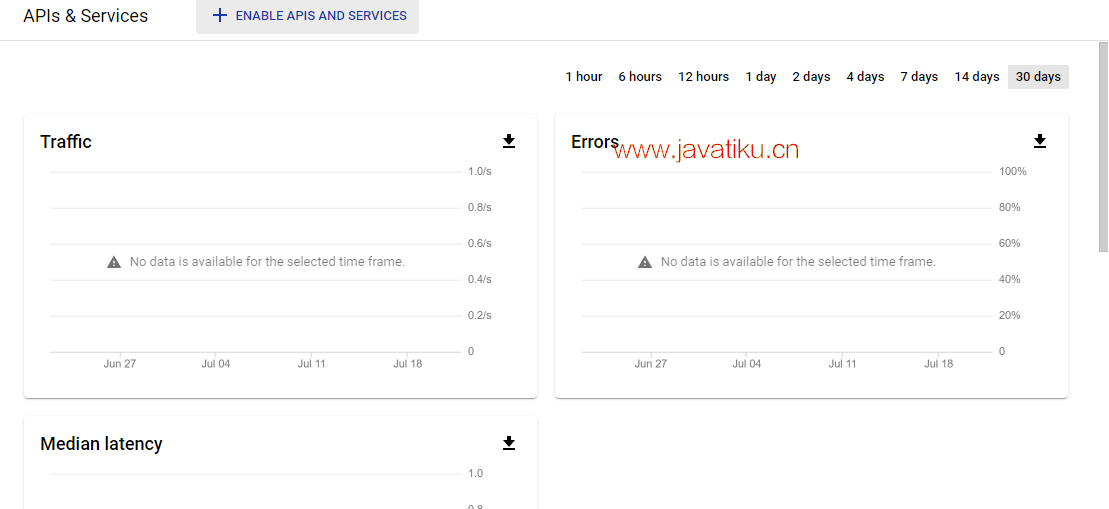
步骤4:配置同意屏幕:
现在,在这一步中,我们将通过在菜单中点击“OAuth同意屏幕”选项来配置我们创建的项目的同意屏幕。只有在同意屏幕尚未配置时,我们才能看到此选项。
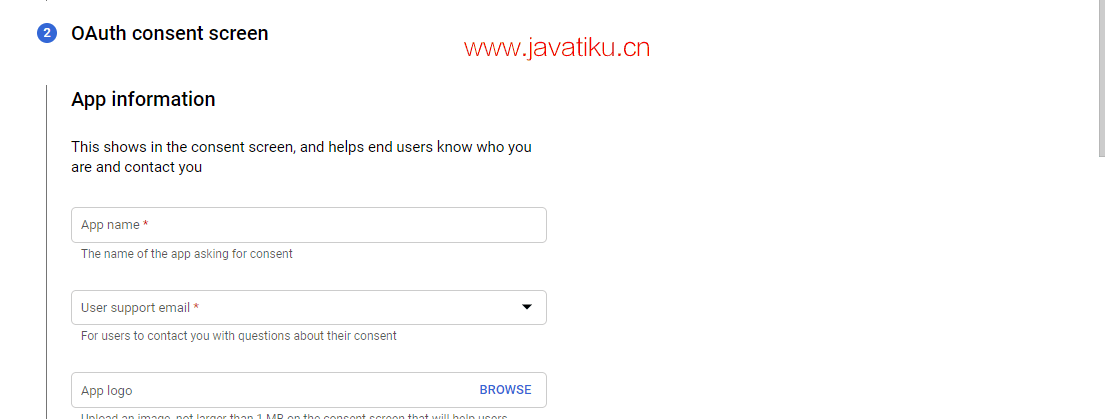
步骤5: 现在,我们必须输入我们选择的应用程序名称并保存项目。
步骤6: 现在,点击凭据选项,然后转到凭据。
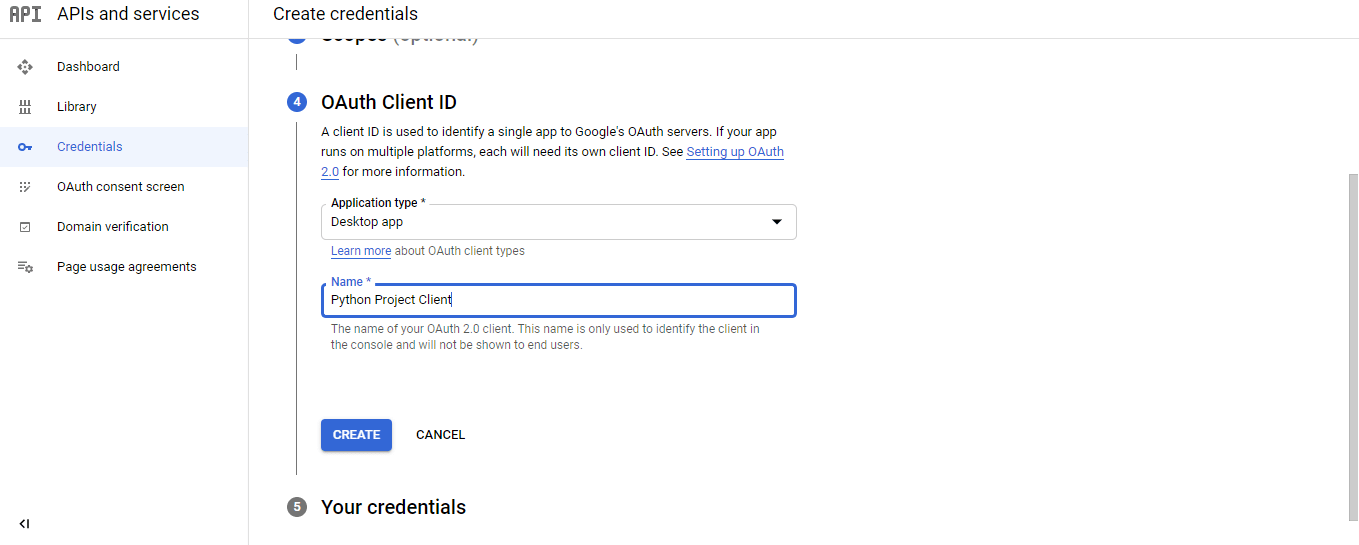
步骤7:创建OAuth客户端ID:
现在,我们点击“创建凭据”选项,然后转到OAuth客户端ID以创建它。
我们通过按照下面的顺序过程来为我们的项目创建一个新的OAuth客户端ID:
- 首先,我们选择应用程序类型作为项目的桌面应用程序。 ![Python中的Gmail API]
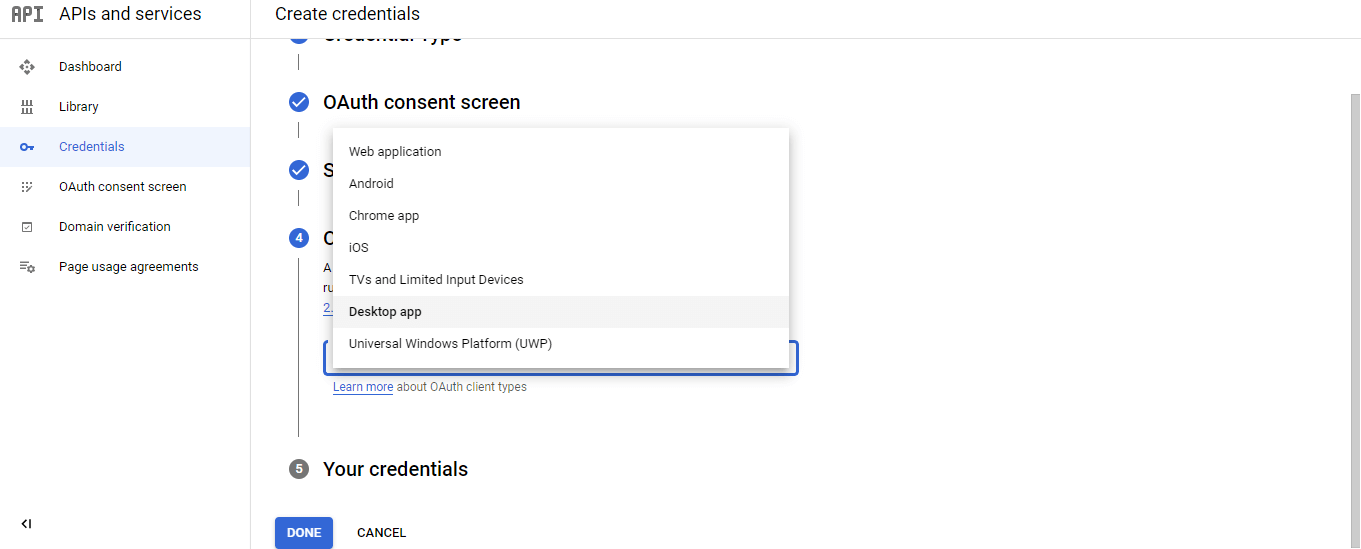
- 然后,我们输入应用程序名称(可以与我们在上面的步骤中设置的名称相同,也可以是不同的名称),然后点击创建按钮。
- 现在,OAuth客户端ID将为我们的项目创建,我们将其下载并以'credentials.json'的名称和格式保存供将来参考。
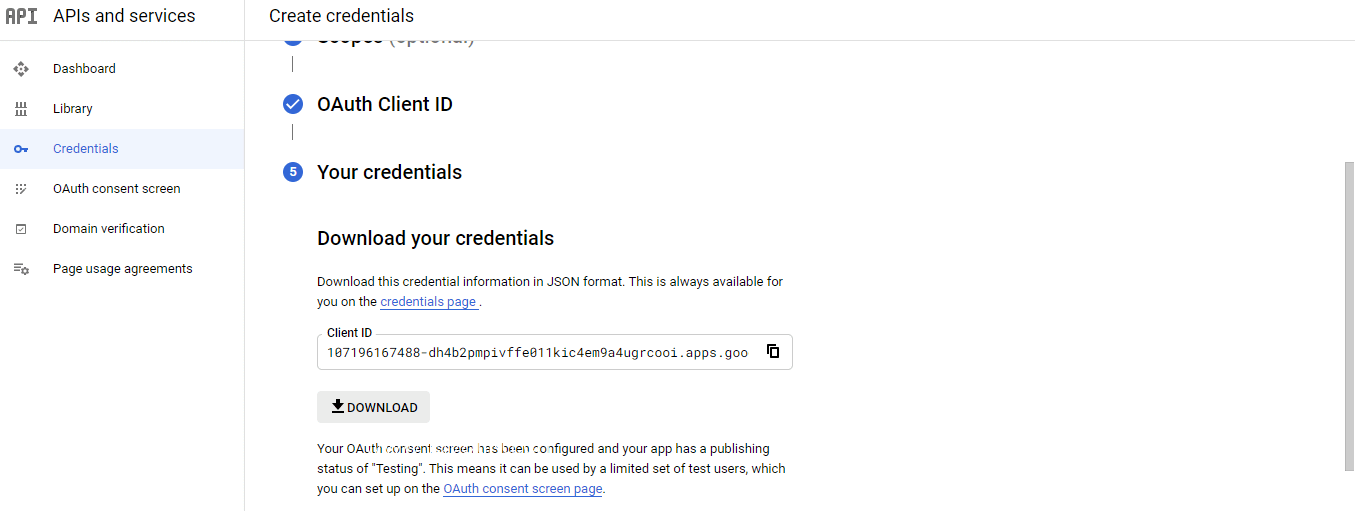
现在,我们已经完成了启用Gmail API的所有步骤,我们可以开始在我们的Python脚本中使用Gmail API。
注意:我们必须保存客户端ID和密码,以便以后如果需要,我们可以在参考资料中使用它们。
导入必要的模块
现在,我们已经设置了所有必要的API,并且应该继续导入所有必要的模块。让我们看一下以下导入模块的示例。
示例 -
# Importing os and pickle module in program
import os
import pickle
# Creating utils for Gmail APIs
from googleapiclient.discovery import build
from google_auth_oauthlib.flow import InstalledAppFlow
from google.auth.transport.requests import Request
# Importing libraries for encoding/decoding messages in base64
from base64 import urlsafe_b64decode, urlsafe_b64encode
# Importing libraries for dealing with the attachment of MIME types in Gmail
from email.mime.text import MIMEText
from email.mime.multipart import MIMEMultipart
from email.mime.image import MIMEImage
from email.mime.audio import MIMEAudio
from email.mime.base import MIMEBase
from email.mime.multipart import MIMEMultipart
from mimetypes import guess_type as guess_mime_type
# Request all access from Gmail APIs and project
SCOPES = ['https://mail.google.com/']
OurEmailID = 'OurMail@gmail.com' # giving our Gmail Id
# using a default function to authenticate Gmail APIs
def authenticateGmailAPIs():
creds = None
# Authorizing the Gmail APIs with tokens of pickles
if os.path.exists("token.pickle"): # using if else statement
with open("token.pickle", "rb") as token:
creds = pickle.load(token)
# If there are no valid credentials available in device, we will let the user sign in manually
if not creds or not creds.valid:
if creds and creds.expired and creds.refresh_token:
creds.refresh(Request())
else:
flow = InstalledAppFlow.from_client_secrets_file('client_secret_107196167488-dh4b2pmpivffe011kic4em9a4ugrcooi.apps.googleusercontent.com.json', SCOPES) # downloaded credential name
creds = flow.run_local_server(port=0) # running credentials
# Save the credentials for the next run
with open("token.pickle", "wb") as token:
pickle.dump(creds, token)
return build('Gmail', 'v1', credentials=creds) # using Gmail to authenticate
# Get the Gmail API service by calling the function
service = authenticateGmailAPIs() 输出:
Please visit this URL to authorize this application: https://accounts.google.com/o/oauth2/auth?response_type=code&client_id=107196167488-dh4b2pmpivffe011kic4em9a4ugrcooi.apps.googleusercontent.com&redirect_uri=http%3A%2F%2Flocalhost%3A55991%2F&scope=https%3A%2F%2Fmail.google.com%2F&state=kfXlNyjvbKetyUK0op7OF9WY7shrKS&access_type=offline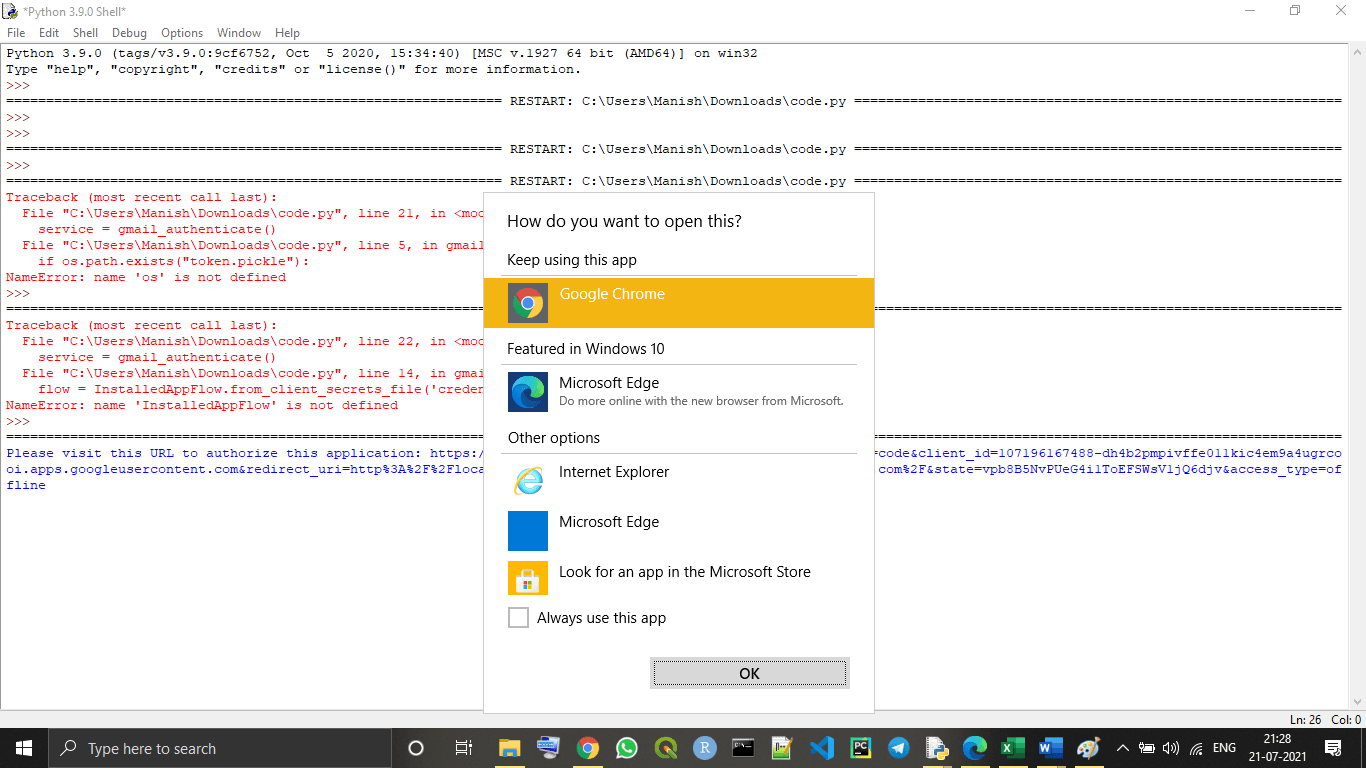
解释 -
当我们运行上面的程序时,我们将看到选择浏览器的选项,如上图所示,如果我们不看到这样的选项,我们需要点击输出中给出的链接。然后,我们可以选择我们选择的浏览器或系统的默认浏览器来继续该过程。现在,当我们选择浏览器时,我们将被重定向到我们的浏览器,并且可以在其中看到以下选项卡已打开:
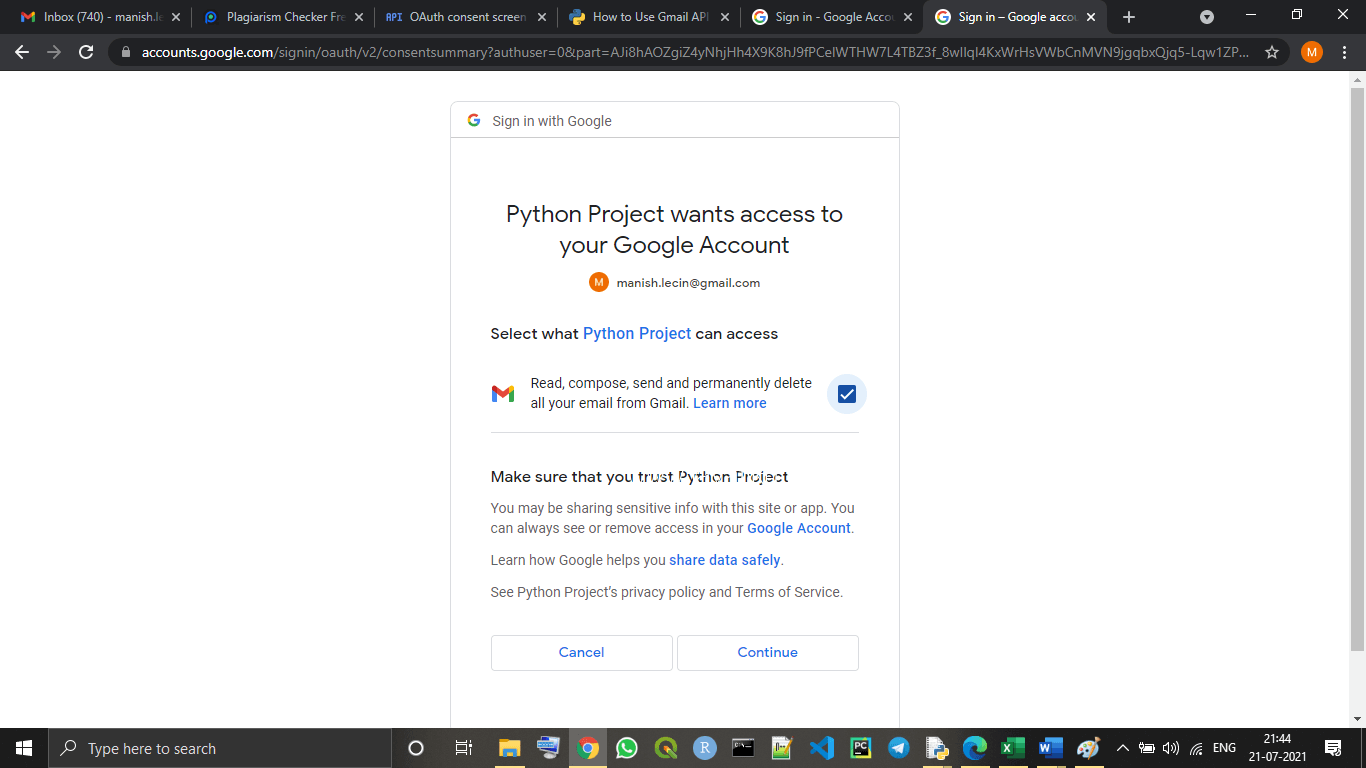
现在,我们在对话框中显示的复选框选项,以给予所需的权限,然后,我们必须单击继续选项。单击继续后,我们可以在同一选项卡中看到以下窗口将打开:
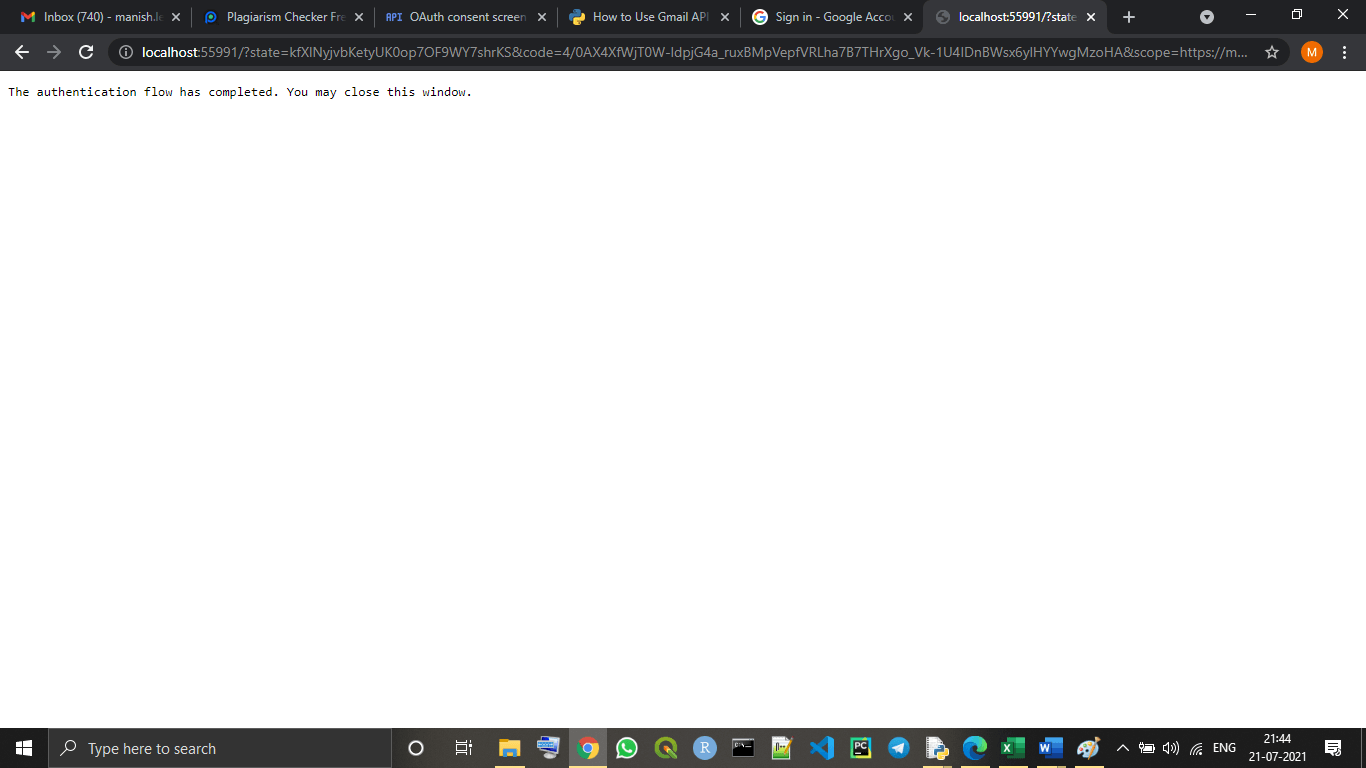
正如窗口所显示的,启用Gmail API的身份验证部分已完成,并且我们已将我们的Gmail帐户与我们创建的Gmail API项目链接起来。
注意:当然,我们必须将我们可以连接到Gmail API并在将来的参考中使用的邮件放在我们上面程序中提供的mailto:Reciever@gmail.com的位置。
在Python中使用Gmail API执行操作
现在,我们已经完全设置并在我们的项目中启用了Gmail API,并且使用了Python脚本。现在,我们可以使用Python程序从我们的Gmail帐户执行许多操作。
我们可以使用启用的Gmail API在我们的Python脚本中执行以下Gmail操作:
- 发送电子邮件
- 搜索电子邮件
- 删除电子邮件或整个电子邮件历史记录
- 阅读电子邮件
- 标记已读/未读电子邮件等。
在本教程中,我们将只学习如何在Python程序中使用Gmail API发送电子邮件,并且我们将学习编写代码以在Python脚本中执行此操作。
发送电子邮件
我们可以通过编写一个Python程序并在其中使用启用的Gmail API来编写和发送电子邮件。在这里,在本节中,我们将编写一个Python程序,通过运行该程序,我们可以从我们的Gmail帐户发送电子邮件。
请查看以下Python程序,以更好地了解它:
# importing os and pickle module in program
import os
import pickle
# Creating utils for Gmail APIs
from googleapiclient.discovery import build
from google_auth_oauthlib.flow import InstalledAppFlow
from google.auth.transport.requests import Request
# Importing libraries for encoding/decoding messages in base64
from base64 import urlsafe_b64decode, urlsafe_b64encode
# Importing libraries for dealing with the attachment of MIME types in Gmail
from email.mime.text import MIMEText
from email.mime.multipart import MIMEMultipart
from email.mime.image import MIMEImage
from email.mime.audio import MIMEAudio
from email.mime.base import MIMEBase
from email.mime.multipart import MIMEMultipart
from mimetypes import guess_type as guess_mime_type
# Request all access from Gmail APIs and project
SCOPES = ['https://mail.google.com/'] # providing the scope for Gmail APIs
OurEmailID = 'OurMail@gmail.com' # giving our Gmail Id
# using a default function to authenticate Gmail APIs
def authenticateGmailAPIs():
creds = None
# authorizing the Gmail APIs with tokens of pickles
if os.path.exists("token.pickle"): # using if else statement
with open("token.pickle", "rb") as token:
creds = pickle.load(token)
# if there are no valid credentials available in device, we will let the user sign in manually
if not creds or not creds.valid:
if creds and creds.expired and creds.refresh_token:
creds.refresh(Request())
else:
flow = InstalledAppFlow.from_client_secrets_file('client_secret_107196167488-dh4b2pmpivffe011kic4em9a4ugrcooi.apps.googleusercontent.com.json', SCOPES) # downloaded credential name
creds = flow.run_local_server(port=0) # running credentials
# save the credentials for the next run
with open("token.pickle", "wb") as token:
pickle.dump(creds, token)
return build('gmail', 'v1', credentials=creds) # using Gmail to authenticate
# Get the Gmail API service by calling the function
ServicesGA = authenticateGmailAPIs()
# Using a default funnction to add attachments in Mail
def AddAttachment(mail, NameofFile):
content_type, encoding = guess_mime_type(NameofFile)
if content_type is None or encoding is not None: # defining none file type attachment
content_type = 'application/octet-stream'
main_type, sub_type = content_type.split('/', 1)
if main_type == 'text': # defining text file type attachment
fp = open(NameofFile, 'rb') # opening file
msg = MIMEText(fp.read().decode(), _subtype = sub_type)
fp.close()
elif main_type == 'image': # defining image file type attachment
fp = open(NameofFile, 'rb')
msg = MIMEImage(fp.read(), _subtype = sub_type)
fp.close()
elif main_type == 'audio': # defining audio file type attachment
fp = open(NameofFile, 'rb')
msg = MIMEAudio(fp.read(), _subtype = sub_type) # reading file
fp.close()
else:
fp = open(NameofFile, 'rb')
msg = MIMEBase(main_type, sub_type)
msg.set_payload(fp.read())
fp.close() # closing file
NameofFile = os.path.basename(NameofFile)
msg.add_header('Content-Disposition', 'attachment', NameofFile = NameofFile)
mail.attach(msg) # composing the mail with given attachment
# Creating mail with a default function
def CreateMail(RecieverMail, SubofMail, BodyofMail, attachments=[]): # various import content of mail as function's parameter
# Using if else to check if there is any attachment in mail or not
if not attachments: # no attachment is given in the mail
mail = MIMEText(BodyofMail) # Body of Mail
mail['to'] = RecieverMail # mail ID of Reciever
mail['from'] = OurEmailID # our mail ID
mail['subject'] = SubofMail # Subject of Mail
else: # attachment is given in the mail
mail = MIMEMultipart()
mail['to'] = RecieverMail
mail['from'] = OurEmailID
mail['subject'] = SubofMail
mail.attach(MIMEText(BodyofMail))
for NameofFile in attachments:
AddAttachment(mail, NameofFile)
return {'raw': urlsafe_b64encode(mail.as_bytes()).decode()}
# Creating a default function to send a mail
def SendMail(ServicesGA, RecieverMail, SubofMail, BodyofMail, attachments=[]):
return ServicesGA.users().messages().send(
userId = "me",
body = CreateMail(RecieverMail, SubofMail, BodyofMail, attachments)
).execute() # Body of the mail with execute() function
# Sending an email by adding important content, i.e., Reciever's mail, Subject, Body, etc.
SendMail(ServicesGA, "Reciever@gmail.com", "Python Project i.e., This is the subject of Mail we are sendimg!",
"Now, this is the body of the email we are writing and we can add only written text here!", ["test.txt", "client_secret_107196167488-dh4b2pmpivffe011kic4em9a4ugrcooi.apps.googleusercontent.com.json"]) # calling out default SendMail() function 输出:
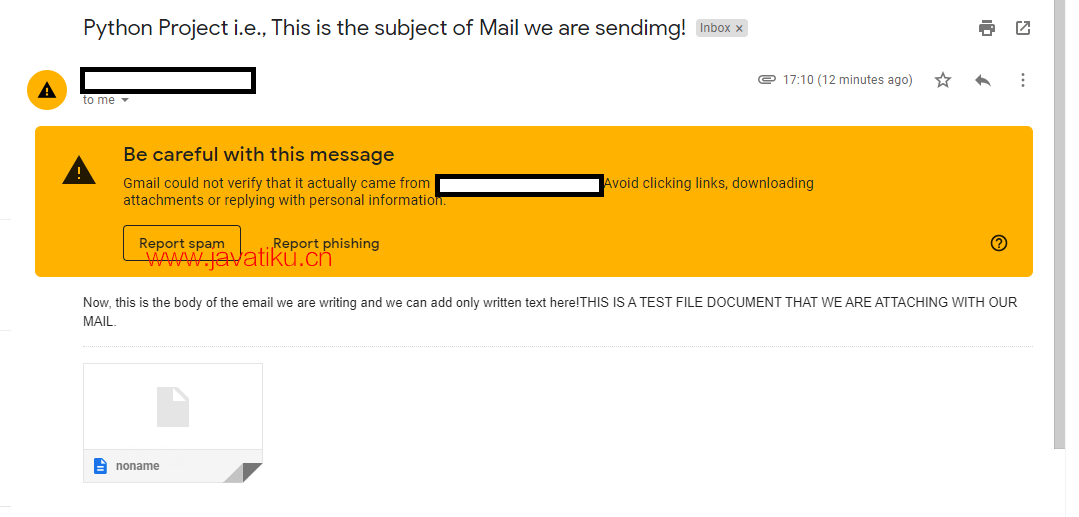
如果我们在接收者的邮件的位置放上我们的邮件,即mailto:Reciever@gmail.com,我们会发现当我们运行该程序时,实际上已将邮件发送到我们在程序中输入为接收者邮件的邮件,与上面输出图像中所看到的相同。
结论
要在Python脚本中使用Gmail API或简单地在Python中使用Gmail API,首先,我们必须启用它们,并在Google云中使用我们的Gmail帐户创建项目。
我们还可以执行许多其他操作,比如阅读,删除等,使用启用的Gmail API在我们的Python程序中,就像发送邮件一样。我们还可以通过运行启用了Gmail API的Python脚本自动化我们的Gmail任务。



